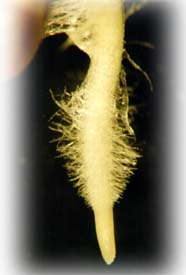Water movement through a plant
by Anne Bruce
(NOTE: moving the mouse over those images with a * will show labelling)
|
We know from a very early age that plants obtain water through their roots, though it is not perhaps until our school biology lessons that we learn of the important role that water plays in the process of photosynthesis. So, water enters the root (often well below the soil surface) and much of it ends up at the leaves, which in some tree species can be up to 100 metres above ground level. How many of us have stopped to consider just how this movement is achieved? The answer is, that a variety of forces and processes are involved. |
|
|
To start with the roots. Most of the water absorption is carried out by the younger part of the roots. Just behind the growing tip of a young root is the piliferous region, made up of hundreds of projections of the epidermal tissue, the root hairs. Root hairs can be seen very clearly in newly germinated seeds, such as the radish (Raphanus sativus) shown here in the photograph. The root hairs are short lived being constantly replaced as new growth takes place |
 |
| The narrow walled hairs greatly increase the surface area over which water absorption can take place. Water in the soil spaces is taken into the root hairs by the process of osmosis1, there being a higher water concentration outside than within the root hair cells. | |
1definition of osmosis - the movement of water from a region where there is a high concentration of water to a region where water concentration is lower, through a selectively permeable membrane.